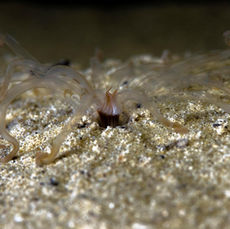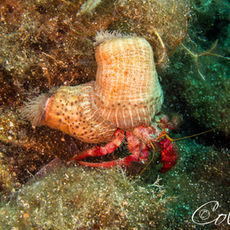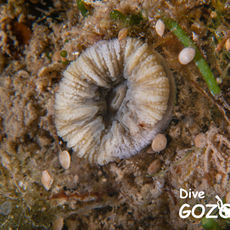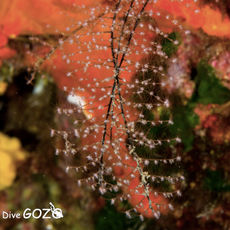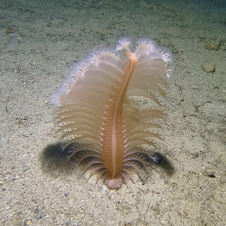Cnidarians
Cnidaria is the higher phylum for the classes Anthozoa, Cubozoa, Hydrozoa and Scyphozoa. All cnidarians have venomous cells (cnidocytes) which are used to catch their prey or as a defence against other predators. The cnidocytes can inflict a toxin into the prey, which in some cases can be deadly to people. They usually come in one of two common forms as either a swimming medusae or as a polyp attached to the substrate. They are all radially symmetrical around a single mouth bordered with tentacles and a body cavity used for digestion. Some like for instance corals, pyrosomes and sea pens, form colonies.
Scyphozoa
Jellyfish
The Scyphozoa are an exclusively marine class of the phylum Cnidaria, which are referred to as the true jellyfish. The phylum Scyphozoa comprises the familiar jellyfishes, they have radial symmetry and are diploblastic, meaning that their body wall consists of the outer epidermis (ectoderm) and the inner gastrodermis (endoderm), which are separated by a mesoglea (hydrostatic skeleton). They have nematocysts; one of the stinging capsular organelles of the tentacle of a cnidarian that contains a coiled, hollow, usually barbed, venomous thread which is discharged especially for catching prey and defending against enemies.
Most jellyfish have two life-stages, a pelagic medusa or jellyfish stage and a bottom dwelling polyp stage.
Anthozoa
Anthozoa is a class of marine invertebrates which includes the sea anemones, stony corals and soft corals. Adult anthozoans are almost all attached to the seabed, while their larvae can disperse as part of the plankton. Wikipedia
Sea Anemones & Tube Dwelling Anemones
Sea anemones are named after the anemone, a terrestrial flowering plant, because of their colourful appearance. Sea anemones are classified in the phylum Cnidaria, class Anthozoa, subclass Hexacorallia. As cnidarians, sea anemones are related to corals, jellyfish, tube-dwelling anemones, and Hydra. Unlike jellyfish, sea anemones do not have a medusa stage in their life cycle. A typical sea anemone is a single polyp attached to a hard surface by its base, but some species live in soft sediment and a few float near the surface of the water. The polyp has a columnar trunk topped by an oral disc with a ring of tentacles and a central mouth. The tentacles can be retracted inside the body cavity or expanded to catch passing prey. They are armed with cnidocytes (stinging cells. Some species of sea anemone live in association with hermit crabs, small fish or other animals to their mutual benefit. Sea anemones breed by liberating sperm and eggs through the mouth into the sea. The resulting fertilized eggs develop into planula larvae which, after being planktonic for a while, settle on the seabed and develop directly into juvenile polyps. Sea anemones also breed asexually, by breaking in half or into smaller pieces which regenerate into polyps. Wikipedia
Symbiosis between Sea Anemone
& Hermit Crab
Stony corals
The Order, Scleractinia, are also called stony corals or hard corals, are marine animals in the phylum Cnidaria that build themselves a hard skeleton. The individual animals are known as polyps and have a cylindrical body crowned by an oral disc in which a mouth is fringed with tentacles. Although some species are solitary, most are colonial. The founding polyp settles and starts to secrete calcium carbonate to protect its soft body. Solitary corals can be as much as 25 cm (10 in) across but in colonial species the polyps are usually only a few millimetres in diameter. These polyps reproduce asexually by budding, but remain attached to each other, forming a multi-polyp colony of clones with a common skeleton, which may be up to several metres in diameter or height according to species.
Hydrozonans
Hydrozoa is a class within the phylum cnidaria. Hydrozoans comes from ancient Greek meaning water and animal, these are a taxonomic class of individually very small, predatory animals, some solitary and some colonial, mostly living in salt water. Lower classes are siphonophores, hydroids and fire corals.
Hydroids
The majority of hydroids are colonial. The original polyp is anchored to a solid substrate and forms a bud which remains attached to its parent. This in turn buds and in this way a stem is formed. The arrangement of polyps and the branching of the stem is characteristic of the species.
Corymorphidae Hydroids
Siphonophores
Siphonophores are colonial hydrozoans that do not exhibit alternation of generations, but instead reproduce asexually through a budding process. Zooids are the multicellular units that build the colonies. A single bud called the pro-bud initiates the growth of a colony by undergoing fission. Wikipedia.
Sea Pens
Sea pens are marine cnidarians within the subphylum Anthozoa, belonging to the order Pennatulacea, which are colony-forming benthic filter feeders within the Class Octocorallia. Sea pens have a worldwide distribution, being found in tropical and temperate waters, from intertidal shallow waters to deep seas of more than 400 m. Although the group is named for its supposed resemblance to antique quill pens, only sea pen species belonging to the Suborder Subselliflorae live up to the comparison. Those belonging to the much larger suborder Sessiliflorae lack feathery structures and grow in club-like or radiating forms. The latter suborder includes what are commonly known as sea pansies.



























